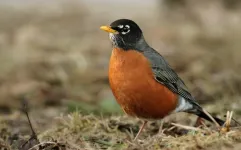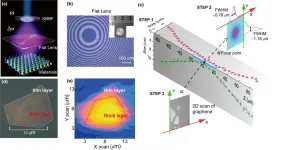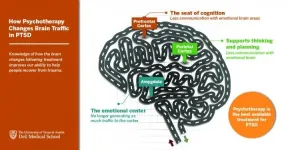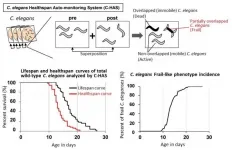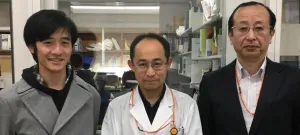(Press-News.org) Birds play an underrecognized role in spreading tickborne disease due to their capacity for long-distance travel and tendency to split their time in different parts of the world - patterns that are shifting due to climate change. Knowing which bird species are able to infect ticks with pathogens can help scientists predict where tickborne diseases might emerge and pose a health risk to people.
A new study published in the journal Global Ecology and Biogeography used machine learning to identify bird species with the potential to transmit the Lyme disease bacterium (Borrelia burgdorferi) to feeding ticks. The team developed a model that identified birds known to spread Lyme disease with 80% accuracy and flagged 21 new species that should be prioritized for surveillance.
Lead author Daniel Becker, a Postdoctoral Fellow at Indiana University, says, "We know birds can infect ticks with the Lyme bacterium; however, until now, no one has systematically studied the ecological and evolutionary drivers that influence which bird species are most likely to host and spread Borrelia burgdorferi on a global scale. We set out to fill this gap by identifying traits of bird species that are most likely to pass Lyme to feeding ticks."
Senior author Barbara Han, a disease ecologist at Cary Institute of Ecosystem Studies, says, "To predict and monitor species that could spread tickborne diseases to people, we first need to know which traits make certain animals good pathogen hosts. Here, we used machine learning to assess bird species traits, paired with Lyme infection data from ticks found on birds, to predict bird species that have the potential to spread Lyme."
In this study, the team searched published literature to locate studies reporting Lyme infection of ticks found feeding on birds. The global search yielded 102 studies, including data from ticks found on 183 bird species; of these, 91 carried ticks that tested positive for Borrelia burgdorferi. These bird species are considered 'competent' reservoir species because they are known to infect feeding ticks with Borrelia burgdorferi. Species flagged have a broad range, reaching across the Americas, Africa, Asia, and Oceania.
Next, machine learning was used to compare traits of competent bird species with 4691 other bird species. Data included information on life history features like diet composition, foraging location, body size, lifespan, reproductive rate, and fledgling age, as well as geographical information like migration distance, global dispersal, and maximum elevation. They also looked at baseline corticosterone - the stress hormone in birds - which can influence susceptibility to infection.
The model identified birds that were known to spread Lyme to ticks with 80% accuracy, and revealed 21 new species that should be prioritized for surveillance based on sharing traits with known competent species. High-risk species tend to have low baseline corticosterone, breed and winter at high latitudes and low elevations, are broadly distributed, and occur on either extreme of the pace-of-life continuum (species that breed early and die young, or breed late and are longer lived).
Species from the genus Turdus, commonly known as true thrushes, were found to have a significantly greater likelihood of competence compared to other taxa. This finding suggests that thrushes might be the riskiest bird species for Lyme transmission. Passerines, or perching birds, also tended to have higher competence, as did birds that primarily eat seeds and those that forage on the ground - a behavior that would put them in reach of questing ticks.
Identifying Lyme-competent bird species could have direct implications for our health. Tickborne diseases, especially Lyme disease, can be difficult to diagnose. Knowing where ticks and the diseases they carry are spreading can help medical practitioners prepare for diagnosis and treatment, improving health outcomes for patients.
Due to climate change, the breeding ranges of many birds are shifting north. As birds spread into higher latitudes, so do ticks and pathogens. Some bird species have taken up full or part-time residence in cities and suburbs. Birds that can succeed in developed environments, especially those that are overwintering in these new places in close proximity to people, increase residents' risk of contracting a tickborne disease.
Becker says, "Birds don't spread Lyme directly to people, but they can carry infected ticks to new locations with no history of Lyme occurrence. A tick could drop off a bird and into a garden or yard, where it could later bite and infect a person. If local medical practitioners are unfamiliar with Lyme symptoms, proper diagnosis could be delayed. Identifying where ticks are spreading could improve medical response to Lyme and other tickborne diseases."
Han concludes, "These findings remind us that pathogen competence varies tremendously, even among animals of the same family. Machine learning techniques allow us to analyze animal traits and help us predict risky species on a global scale - not only for Lyme, but for other tickborne and zoonotic diseases that involve multiple host species. These predictions could provide crucial information to guide early interventions, prevent disease spillover, and protect our health."
INFORMATION:
Investigators:
Daniel Becker - Department of Biology, Indiana University; Center for the Ecology of Infectious Disease, University of Georgia
Barbara Han - Cary Institute of Ecosystem Studies
BirdLife International provided avian distribution data. Funding to support authors was provided by the National Science Foundation Ecology and Evolution of Infectious Diseases program (DEB-1717282 and DEB-1619072) and Oak Ridge Institute for Science and Education through an interagency agreement between the U.S. Department of Energy and the Office of the Director of National Intelligence.
DOI: https://doi.org/10.1101/2020.04.15.040352
Cary Institute of Ecosystem Studies is an independent nonprofit center for environmental research. Since 1983, our scientists have been investigating the complex interactions that govern the natural world and the impacts of climate change on these systems. Our findings lead to more effective management and policy actions and increased environmental literacy. Staff are global experts in the ecology of: cities, disease, forests, and freshwater.
The rapid development of two-dimensional quantum materials, such as twisted bilayer graphene, monolayer copper superconductors, and quantum spin Hall materials, has demonstrated both important scientific implications and promising application potential. To characterize the electronic structure of these materials/devices, angle-resolved photoemission spectroscopy (ARPES) is commonly used to measure the energy and momentum of electrons photoemitted from samples illuminated by X-ray or vacuum ultraviolet (VUV) light sources. Although the X-ray-based spatially resolved ARPES has the highest spatial resolution (~100 nm) benefitting from the relatively short wavelength, its energy resolution is typically mediocre (>10 meV), ...
The overuse of antibiotics occurs due to the mistaken widespread belief that they are beneficial for a broad array of conditions and because many physicians are willing to prescribe antibiotics if patients ask for the medication, according to a Rutgers study.
The study, published in the journal BioEssays, reviewed more than 200 peer-reviewed studies to examine the causes behind antibiotic overuse, which can lead harmful bacteria to become drug-resistant and cause harmful effects on the microbiome, the collection of beneficial germs that live in and on our bodies.
Martin Blaser, director of the Center for Advanced Biotechnology and Medicine at Rutgers and lead author, said the global use of antibiotics between 2000 and 2015 increased 39 percent, with ...
p>AUSTIN, Texas -- Trauma-focused psychotherapy is widely considered the best available treatment for posttraumatic stress disorder (PTSD). However, the ways in which this method affects the brain to promote recovery from PTSD are not well understood. In a END ...
A research group from Kumamoto University (Japan) has developed an automated measurement system to assess healthy lifespans using nematodes (C. elegans). Based on qualitative differences in lifespans, this system can classify populations of nematodes that are, on average, healthy and long-lived, healthy and die prematurely, and living with long periods of poor health. Since there are many similarities between the mechanisms that determine the lifespan of C. elegans and humans, the researchers believe that this system will make it easier to develop drugs and find foods that extend the ...
A tree grows strong from years of generating its own food. Now imagine if products could be strengthened with the same living materials that provide nutrients to strengthen trees. This is the work of USC Viterbi School of Engineering Civil and Environmental Engineering Professor Qiming Wang whose research lab is one of the first to infuse 3-D printer ink with living material. The material has potential for greater strength, to be flexible and self-heal. The work is documented in a paper published in The Proceedings of the National Academy of Sciences.
The idea for this bio-inspired ink came from trees that harness the power of photosynthesis to produce glucose that transform to ...
In our body, unnecessary cells are removed by regulated cell death. Understanding of the mechanism underlying regulated cell death is critical for the development of therapies for many diseases. Professor Nakano's research group has demonstrated that Mind bomb-2 (MIB2), a ubiquitin ligase, binds to and directly ubiquitinates the cell death suppressor protein cFLIP (Cellular FLICE-inhibitory protein). cFLIP is encoded by CFLAR gene; alternative splicing results in two forms, the long form (cFLIPL) and the short form (cFLIPs). cFLIPL plays a dominant role in suppression ...
January 27, 2021 - For many of us, as we get older the skin on our face begins to sag and we seem to lose volume around our eyes, cheeks and chin. Is gravity taking its toll in our later years or do we lose fat over the course of several years that many of us associate with youth, vibrancy and energy? Understanding the cause is paramount to how plastic surgeons treat the signs of facial aging.
The traditional theory is sagging: the facial soft tissues simply yield to the effects of gravity over time. And while the idea that weakening ligaments in the midface could result in soft tissue descent still has merit, more recent studies point in another direction. Perhaps the real culprit behind facial aging ...
Speaking is something that comes across as an effortless process, almost working by itself. Our brain, however, has a lot of work to do when we construct a sentence. "In addition, languages differ in myriad ways and this also means that there are differences in how we plan what we want to say in different languages," says Balthasar Bickel, senior author of the study and a professor at the University of Zurich.
And if some languages seem easier, it is because they make fewer distinctions in their grammar. While English always uses the (e.g., in "The tree is tall" and "Snow covers the tree"), German makes a distinction between der (subject) and den (object) (e.g., in "Der Baum ist groß" and ...
A fifth basic flavour has crept into our conceptualisation of foods in recent years--umami. In Japanese, umami translates roughly to 'savoury deliciousness'.
It is often associated with the earthy flavours of meat, mushrooms, broths and vine-ripened tomatoes. It enhances saltiness and sweetness, while reducing bitterness, which is why most people love it.
But does umami exist in beverages? And if so, which fermented beverage has the most umami potential: wine, beer, sake or champagne? And, what happens to flavours when these beverages are paired with foods?
Three researchers from the University of Copenhagen's ...
Researchers from the Hong Kong University of Science and Technology (HKSUST) and the University of Hong Kong (HKU) recently demonstrated that the selectivity determinant of Origin Recognition Complex (ORC) for DNA binding lies in a 19-amino acid insertion helix in the Orc4 subunit, which is present in yeast but absent in human. Removal of this motif from Orc4 transforms the yeast ORC, which selects origins based on base-specific binding at defined locations, into one whose selectivity is dictated by chromatin landscape (genomic nucleosome profile), a characteristic feature shared by human ORC.
Further understanding of the preferred DNA shapes and nucleosome positioning requirements will provide new insights for the plasticity of the human ORC in selecting replication ...
